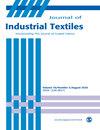木棉/废丝多功能生物基非织造材料的开发与性能研究
IF 2
4区 工程技术
Q1 MATERIALS SCIENCE, TEXTILES
引用次数: 0
摘要
石油废弃物造成的污染推动了生态友好型生物基材料的发展。天然纤维作为一种可再生和可生物降解的资源越来越受欢迎。本研究采用湿法和热压法制备木棉/废丝非织造布(KSN),该材料具有良好的机械强度、亲水性、亲脂性和生物降解性能。研究了木棉纤维配比对KSN的形态、透气性、柔软性、力学性能、润湿性和生物降解性的影响。结果表明:随着木棉纤维掺量的增加,木棉的厚度、孔隙率、透气性和柔软度均有所降低;力学性能显著提高,断裂强度由0.58 MPa提高到10.85 MPa。随着木棉纤维掺量的增加,油和水的涂抹时间分别增加和减少,静态接触角均在50°以下。降解率随木棉纤维掺量的增加而提高,最大降解率为49.41% (30 d)。因此,多功能、低成本、易制备、可生物降解的木棉/废丝无纺布是一种很有前途的生物基材料,在敷料、面膜基材、包装等领域具有很好的应用前景。本文章由计算机程序翻译,如有差异,请以英文原文为准。
Development and characterization of kapok/waste silk nonwoven as a multifunctional bio-based material for textile applications
The pollution caused by petroleum-based waste has motivated the development of ecologically friendly bio-based materials. Natural fibers are becoming increasingly popular as a renewable and biodegradable resource. In this study, we prepared a kapok/waste silk nonwoven (KSN) by wet-laid and hot-pressing, which had adequate mechanical strength, hydrophilic, lipophilic, and biodegradable properties. The effects of the kapok fiber proportion on the morphology, air permeability, softness, mechanical property, wettability, and biodegradability of KSN were studied. The results demonstrated that the thickness, porosity, air permeability, and softness decreased as the proportion of kapok fiber increased. The mechanical property was significantly enhanced, and the breaking strength increased from 0.58 MPa to 10.85 MPa. With the increase in the proportion of kapok fiber, the spreading time of oil and water increased and decreased respectively, and the static contact angles were below 50°. Degradation rate improved with the increase of kapok fiber proportion, with a maximum degradation rate of 49.41% (30 days). Therefore, the multifunctional, low-cost, easily prepared, and biodegradable kapok/waste silk nonwovens is a promising bio-based material with superior application prospects in dressings, facial mask substrate, packaging, and related fields.
求助全文
通过发布文献求助,成功后即可免费获取论文全文。
去求助
来源期刊

Journal of Industrial Textiles
MATERIALS SCIENCE, TEXTILES-
CiteScore
5.30
自引率
18.80%
发文量
165
审稿时长
2.3 months
期刊介绍:
The Journal of Industrial Textiles is the only peer reviewed journal devoted exclusively to technology, processing, methodology, modelling and applications in technical textiles, nonwovens, coated and laminated fabrics, textile composites and nanofibers.
 求助内容:
求助内容: 应助结果提醒方式:
应助结果提醒方式:


